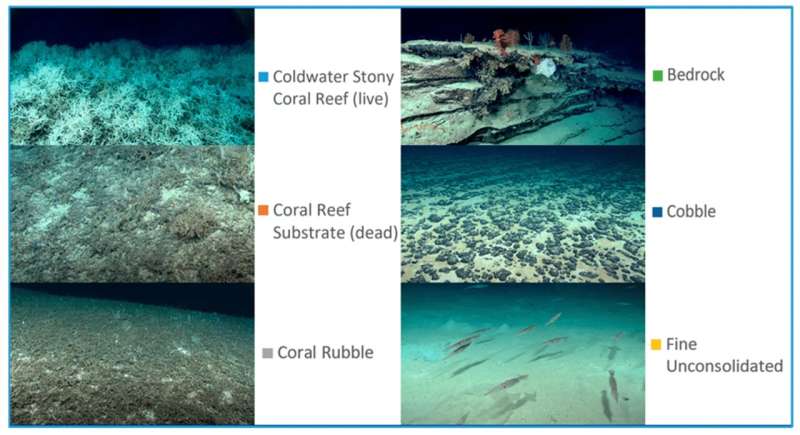This article has been reviewed according to Science X's editorial process and policies. Editors have highlighted the following attributes while ensuring the content's credibility:
fact-checked
reputable news agency
proofread
Deep-sea coral reef stretches 600 miles from Miami to SC, scientists find

The world's largest deep-sea coral reef has been discovered off the East Coast: a massive 6.4 million acre seascape that stretches from Miami to Charleston, South Carolina, according to National Oceanic and Atmospheric Administration Ocean Exploration.
That makes it larger than Vermont, NOAA says.
The discovery, published Jan. 12 in the journal Geomatics, disproves a long held belief that the Blake Plateau in the Atlantic might be a dead zone.
Instead, scientists found a "stunning" ecosystem populated by "dense thickets of the reef-building coral."
"For years we thought much of the Blake Plateau was sparsely inhabited, soft sediment," NOAA Ocean Exploration Operations Chief Kasey Cantwell said in a news release.
"Past studies have highlighted some coral in the region, particularly closer to the coast and in shallower waters, but until we had a complete map of the region, we didn't know how extensive this habitat was, nor how many of these coral mounds were connected."
The reef's borders are between 35 and 75 miles off the coastline, beginning southeast of Miami and moving north to Charleston, South Carolina, NOAA says.
One spot, nicknamed "Million Mounds" by scientists, accounts for the largest part of the reef. It is made up primarily of "a stony coral" commonly found at depths of 656 to 3,280 feet, where temperatures average about 39 degrees, the study reports.
"Cold-water corals such as these grow in the deep ocean where there is no sunlight and survive by filter-feeding biological particles," the scientists reported.
"While they are known to be important ecosystem engineers, creating structures that provide shelter, food, and nursery habitat to other invertebrates and fish, these corals remain poorly understood."
Hints of a massive reef were found in 2019, but scientists waited until a multi-agency effort had mapped the reef before announcing the discovery.
Data from more than 30 multi-beam sonar mapping surveys (and 23 submersible dives) was combined to create a nearly complete map. In the process, the team "identified 83,908 individual coral mound peak features," according to the news release.
"The study documents the massive scale of the coral province, an area composed of nearly continuous coral mound features that span up to 500 kilometers (310 miles) long and 110 kilometers (68 miles) wide," the scientists reported.
A "core area" has high-density mounds up to 158 miles long and 26 miles wide, the report states.
In addition to NOAA Ocean Exploration, the multi-year exploration campaign included the Ocean Exploration Trust, the University of New Hampshire, the Bureau of Ocean Energy Management, Temple University and the U.S. Geological Survey.
"This strategic multiyear and multi-agency effort to systematically map and characterize the stunning coral ecosystem ... is a perfect example of what we can accomplish when we pool resources," according Derek Sowers, lead author of the study and Mapping Operations Manager for the Ocean Exploration Trust.
More information: Derek C. Sowers et al, Mapping and Geomorphic Characterization of the Vast Cold-Water Coral Mounds of the Blake Plateau, Geomatics (2024). DOI: 10.3390/geomatics4010002
2024 The Charlotte Observer. Distributed by Tribune Content Agency, LLC.


















